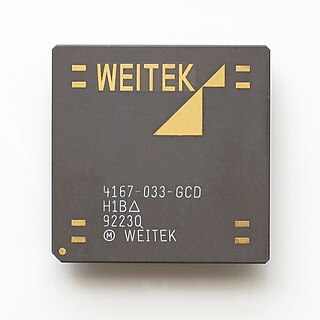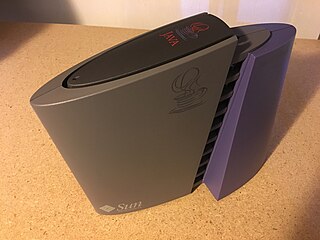Visual Instruction Set, or VIS, is a SIMD instruction set extension for SPARC V9 microprocessors developed by Sun Microsystems. There are five versions of VIS: VIS 1, VIS 2, VIS 2+, VIS 3 and VIS 4.

Meiko Scientific Ltd. was a British supercomputer company based in Bristol, founded by members of the design team working on the Inmos transputer microprocessor.

Weitek Corporation was an American chip-design company that originally focused on floating-point units for a number of commercial CPU designs. During the early to mid-1980s, Weitek designs could be found powering a number of high-end designs and parallel-processing supercomputers.

The Sun Ray was a stateless thin client computer aimed at corporate environments, originally introduced by Sun Microsystems in September 1999 and discontinued by Oracle Corporation in 2014. It featured a smart card reader and several models featured an integrated flat panel display.

The SPARCstation, SPARCserver and SPARCcenter product lines are a series of SPARC-based computer workstations and servers in desktop, desk side (pedestal) and rack-based form factor configurations, that were developed and sold by Sun Microsystems.

MBus is a computer bus designed and implemented by Sun Microsystems for communication between high speed computer system components, such as the central processing unit, motherboard and main memory. SBus is used in the same machines to connect add-on cards to the motherboard.

The SPARCstation 20 or SS20 is a discontinued Sun Microsystems workstation introduced in March 1994 based on the SuperSPARC or hyperSPARC CPU. It is one of the last models in the SPARCstation family of Sun "pizza box" computers, which was superseded by the UltraSPARC design in 1995.

SPARCstation 5 or SS5 is a workstation introduced by Sun Microsystems in March 1994. It is based on the sun4m architecture, and is enclosed in a pizza-box chassis. Sun also offered a SPARCserver 5 without a framebuffer. A simplified, cheaper version of the SS5 was released in February 1995 as the SPARCstation 4. Sun also marketed these same machines under the "Netra" brand, without framebuffers or keyboards and preconfigured with all the requisite software to be used as web servers. An estimated 400,000+ SPARCstation 5s were sold.

Sun Microsystems' UltraSPARC T1 microprocessor, known until its 14 November 2005 announcement by its development codename "Niagara", is a multithreading, multicore CPU. Designed to lower the energy consumption of server computers, the CPU typically uses 72 W of power at 1.4 GHz.

The JavaStation was a Network Computer (NC) developed by Sun Microsystems between 1996 and 2000, intended to run only Java applications.
Sun-4 is a series of Unix workstations and servers produced by Sun Microsystems, launched in 1987. The original Sun-4 series were VMEbus-based systems similar to the earlier Sun-3 series, but employing microprocessors based on Sun's own SPARC V7 RISC architecture in place of the 68k family processors of previous Sun models.

Sun Microsystems' UltraSPARC T2 microprocessor is a multithreading, multi-core CPU. It is a member of the SPARC family, and the successor to the UltraSPARC T1. The chip is sometimes referred to by its codename, Niagara 2. Sun started selling servers with the T2 processor in October 2007.
Ross Technology, Inc. was a semiconductor design and manufacturing company, specializing in SPARC microprocessors. It was founded in Austin, Texas in August 1988 by Dr. Roger D. Ross, a leading computer scientist who headed Motorola's Advanced Microprocessor Division and directed the developments of Motorola's MC68030 and RISC-based 88000 microprocessor families.
The SPARC64 V (Zeus) is a SPARC V9 microprocessor designed by Fujitsu. The SPARC64 V was the basis for a series of successive processors designed for servers, and later, supercomputers.

The UltraSPARC III, code-named "Cheetah", is a microprocessor that implements the SPARC V9 instruction set architecture (ISA) developed by Sun Microsystems and fabricated by Texas Instruments. It was introduced in 2001 and operates at 600 to 900 MHz. It was succeeded by the UltraSPARC IV in 2004. Gary Lauterbach was the chief architect.

The UltraSPARC II, code-named "Blackbird", is a microprocessor implementation of the SPARC V9 instruction set architecture (ISA) developed by Sun Microsystems. Marc Tremblay was the chief architect. Introduced in 1997, it was further development of the UltraSPARC operating at higher clock frequencies of 250 MHz, eventually reaching 650 MHz.

The TurboSPARC is a microprocessor that implements the SPARC V8 instruction set architecture (ISA) developed by Fujitsu Microelectronics, Inc. (FMI), the United States subsidiary of the Japanese multinational information technology equipment and services company Fujitsu Limited located in San Jose, California. It was a low-end microprocessor primarily developed as an upgrade for the Sun Microsystems microSPARC-II-based SPARCstation 5 workstation. It was introduced on 30 September 1996, with a 170 MHz version priced at US$499 in quantities of 1,000. The TurboSPARC was mostly succeeded in the low-end SPARC market by the UltraSPARC IIi in late 1997, but remained available.

The SuperSPARC is a microprocessor that implements the SPARC V8 instruction set architecture (ISA) developed by Sun Microsystems. 33 and 40 MHz versions were introduced in 1992. The SuperSPARC contains 3.1 million transistors. It was fabricated by Texas Instruments (TI) at Miho, Japan in a 0.8 micrometre triple-metal BiCMOS process.

The SPARCclassic is a workstation introduced by Sun Microsystems in November 1992. It is based on the sun4m architecture, and is enclosed in a lunchbox chassis. It shares the code name Sunergy with the SPARCclassic X, SPARCstation LX, and SPARCstation ZX. It was replaced by the SPARCstation 4 in February 1994.
The SPARCstation LX is a workstation that was designed, manufactured, and sold by Sun Microsystems. Introduced in November 1992, it is based on the sun4m architecture and enclosed in a lunchbox chassis. It shares the code name Sunergy with the low-end range of SPARCclassic, SPARCclassic X, and SPARCstation ZX.















